Study on the Penetration Power of ZrO2 Toughened Al2O3 Ceramic Composite Projectile into Ceramic Composite Armor
Abstract
:1. Introduction
2. Test Preparation
2.1. Selection of ZTA Bullet Tip Material
2.2. Preparation Process of ZTA Projectile Material
2.3. Micro Fracture Analysis of ZTA Material
2.4. Experiment of Penetration Power
3. Simulation Calculation
3.1. Simulation Model
3.2. Material Parameters
4. Results and Analysis
4.1. Penetration of RHA Armor Steel
4.1.1. Experiment Results
4.1.2. Simulation Analysis
4.2. Penetration of Al2O3/RHA Composite Armor
4.2.1. Test Results
4.2.2. Simulation Analysis
5. Penetration Power Calculation
6. Conclusions
Author Contributions
Funding
Institutional Review Board Statement
Informed Consent Statement
Data Availability Statement
Conflicts of Interest
References
- Hu, D.; Zhang, Y.; Shen, Z.; Cai, Q. Investigation on the ballistic behavior of mosaic SiC/UHMWPE composite armor systems. Ceram. Int. 2017, 43, 10368–10376. [Google Scholar] [CrossRef]
- Shen, Y.; Wang, Y.; Du, S.; Yang, Z.; Cheng, H.; Wang, F. Effects of the adhesive layer on the multi-hit ballistic performance of ceramic/metal composite armors. J. Mater. Res. Technol. 2021, 13, 1496–1508. [Google Scholar] [CrossRef]
- Gao, Y.; Zhang, W.; Xu, P.; Cai, X.; Fan, Z. Influence of epoxy adhesive layer on impact performance of TiB2-B4C composites armor backed by aluminum plate. Int. J. Impact Eng. 2018, 122, 60–72. [Google Scholar] [CrossRef]
- Khan, M.A.; Wang, Y.; Yasin, G.; Malik, A.; Nazeer, F.; Khan, W.Q.; Zhang, H.; Ahmed, T. Microstructure characteristic of spray formed 7055 Al alloy subjected to ballistic impact by two different steel core projectiles impact. J. Mater. Res. Technol. 2019, 8, 6177–6190. [Google Scholar] [CrossRef]
- Crouch, I.G. Body armour—New materials, new systems. Def. Technol. 2019, 15, 241–253. [Google Scholar] [CrossRef]
- Wang, B.; Lu, G. On the optimisation of two-component plates against ballistic impact. J. Mater. Process. Technol. 1996, 57, 141–145. [Google Scholar] [CrossRef]
- Lee, M.; Yoo, Y.H. Analysis of ceramic/metal armour systems. Int. J. Impact Eng. 2001, 25, 819–829. [Google Scholar] [CrossRef]
- Ning, J.; Ren, H.; Guo, T.; Li, P. Dynamic response of alumina ceramics impacted by long tungsten projectile. Int. J. Impact Eng. 2013, 62, 60–74. [Google Scholar] [CrossRef]
- Zhai, Y.X.; Wu, H.; Fang, Q. Interface defeat studies of long-rod projectile impacting on ceramic targets. Def. Technol. 2020, 16, 50–68. [Google Scholar] [CrossRef]
- Sadanandan, S.; Hetherington, J.G. Characterisation of ceramic/steel and ceramic/aluminium armours subjected to oblique impact. Int. J. Impact Eng. 1997, 19, 811–819. [Google Scholar] [CrossRef]
- Hetherington, J.G.; Lemieux, P.F. The effect of obliquity on the ballistic performance of two component composite armours. Int. J. Impact Eng. 1994, 15, 131–137. [Google Scholar] [CrossRef]
- Hauver, G.E.; Rapacki, E.J.; Netherwood, P.H.; Benck, R.F. Interface Defeat of Long-Rod Projectiles by Ceramic Armor; Army Research Laboratory Report ARL-TR-3590; Army Research Laboratory: Adelphi, MD, USA, 2005; p. 85. [Google Scholar]
- Medvedovski, E. Ballistic performance of armour ceramics: Influence of design and structure. Part 2. Ceram. Int. 2010, 36, 2117–2127. [Google Scholar] [CrossRef]
- Wang, X.; Li, C.; Du, Q.; Zhou, Q.; Qi, J.; Si, X.; Cao, J. Brazing ZTA ceramic and Ti6Al4V alloy directly in air: Excellent oxidation resistance at 800 °C. Ceram. Int. 2022, 48, 9631–9639. [Google Scholar] [CrossRef]
- Hogan, J.D.; Farbaniec, L.; Mallick, D.; Domnich, V.; Kuwelkar, K.; Sano, T.; McCauley, J.W.; Ramesh, K.T. Fragmentation of an advanced ceramic under ballistic impact: Mechanisms and microstructure. Int. J. Impact Eng. 2017, 102, 47–54. [Google Scholar] [CrossRef]
- Lo, C.; Sano, T.; Hogan, J.D. Deformation mechanisms and evolution of mechanical properties in damaged advanced ceramics. J. Eur. Ceram. Soc. 2020, 40, 3129–3139. [Google Scholar] [CrossRef]
- Ren, K.; Feng, S.; Chen, Z.; Zhao, T.; Yin, L.; Fu, J. Study on the Penetration Performance of a 5.8 mm Ceramic Composite Projectile. Materials 2021, 14, 721. [Google Scholar] [CrossRef]
- Khan, M.K.; Iqbal, M.A.; Bratov, V.; Morozov, N.F.; Gupta, N.K. An investigation of the ballistic performance of independent ceramic target. Thin-Walled Struct. 2020, 154, 106784. [Google Scholar] [CrossRef]
- Cao, J.; Lai, J.; Zhou, J.; Kang, N.; Du, L.; Miao, Y. Experiments and simulations of the ballistic response of ceramic composite armors. J. Mech. Sci. Technol. 2020, 34, 2783–2793. [Google Scholar] [CrossRef]
- Jena, P.K.; Mishra, B.; Siva Kumar, K.; Bhat, T.B. An experimental study on the ballistic impact behavior of some metallic armour materials against 7.62 mm deformable projectile. Mater. Des. 2010, 31, 3308–3316. [Google Scholar] [CrossRef]
- Normandia, M.J.; La Salvia, J.C.; Gooch, W.; McCauley, J.W.; Rajendran, A. Protecting the Future Force: Ceramics Research Leads to Improved Armor Performance. Amptiac Q. 2004, 8, 21–27. [Google Scholar]
- Krishnan, K.; Sockalingam, S.; Bansal, S.; Rajan, S.D. Numerical simulation of ceramic composite armor subjected to ballistic impact. Compos. Part B Eng. 2010, 41, 583–593. [Google Scholar] [CrossRef]
- Hu, D.-Q.; Wang, J.-R.; Yin, L.-K.; Chen, Z.-G.; Yi, R.-C.; Lu, C.-H. Experimental study on the penetration effect of ceramics composite projectile on ceramic/A3 steel compound targets. Def. Technol. 2017, 13, 281–287. [Google Scholar] [CrossRef]
- Gour, G.; Idapalapati, S.; Goh, W.L.; Shi, X. peng Equivalent protection factor of bi-layer ceramic metal structures. Def. Technol. 2022, 18, 384–400. [Google Scholar] [CrossRef]
- Nevarez-Rascon, A.; Aguilar-Elguezabal, A.; Orrantia, E.; Bocanegra-Bernal, M.H. On the wide range of mechanical properties of ZTA and ATZ based dental ceramic composites by varying the Al2O3 and ZrO2 content. Int. J. Refract. Met. Hard Mater. 2009, 27, 962–970. [Google Scholar] [CrossRef]
- Sarker, S.; Tabassum, H.; Alam, Z.; Gafur, M.A. Materials Today: Proceedings Impacts of inclusion of additives on physical, microstructural, and mechanical properties of Alumina and Zirconia toughened alumina (ZTA) ceramic composite: A review. Mater. Today Proc. 2022. [CrossRef]
- Kurzawa, A.; Pyka, D.; Jamroziak, K.; Bajkowski, M.; Bocian, M.; Magier, M.; Koch, J. Assessment of the impact resistance of a composite material with EN AW-7075 matrix reinforced with α-Al2O3 particles using a 7.62 × 39 mm projectile. Materials 2020, 13, 769. [Google Scholar] [CrossRef] [Green Version]
- Zochowski, P.; Bajkowski, M.; Grygoruk, R.; Magier, M.; Burian, W.; Pyka, D.; Bocian, M.; Jamroziak, K. Comparison of Numerical Simulation Techniques of Ballistic Ceramics under Projectile Impact Conditions. Materials 2022, 15, 18. [Google Scholar] [CrossRef]
- Chen, W.W.; Rajendran, A.M.; Song, B.; Nie, X. Dynamic fracture of ceramics in armor applications. J. Am. Ceram. Soc. 2007, 90, 1005–1018. [Google Scholar] [CrossRef]
- Nechitailo, N.V.; Batra, R.C. Penetration/perforation of aluminum, steel and tungsten plates by ceramic rods. Comput. Struct. 1998, 66, 571–583. [Google Scholar] [CrossRef]
- Nechitailo, N.V. Advanced high-speed ceramic projectiles against hard targets. IEEE Trans. Magn. 2009, 45, 614–619. [Google Scholar] [CrossRef]
- Huang, D.Y.; Zhang, Y.Y.; Wang, J.R.; Wang, S.Z. A Study on Distance—Decay of Spherical Ceramic Fragments with Low Collateral Damage. J. Proj. Rocket. Missiles Guid. 2011, 31, 100–102. [Google Scholar] [CrossRef]
- Yi, R.C.; Wang, J.R.; Zan, S.D.; Chen, Z.G.; Hu, D.Q. Research on Penetration Performance of Non-penetrating Ceramic Bullet. Acta Armamentarii 2016, 37, 49–54. [Google Scholar]
- Tate, A. A theory for the deceleration of long rods after impact. J. Mech. Phys. Solids 1967, 15, 387–399. [Google Scholar] [CrossRef]
- Alekseevskii, V.P. Penetration of a rod into a target at high velocity. Combust. Explos. Shock Waves 1966, 2, 99–106. [Google Scholar] [CrossRef]
- Tate, A. Long rod penetration models-Part II. Extensions to the hydrodynamic theory of penetration. Int. J. Mech. Sci. 1986, 28, 599–612. [Google Scholar] [CrossRef]

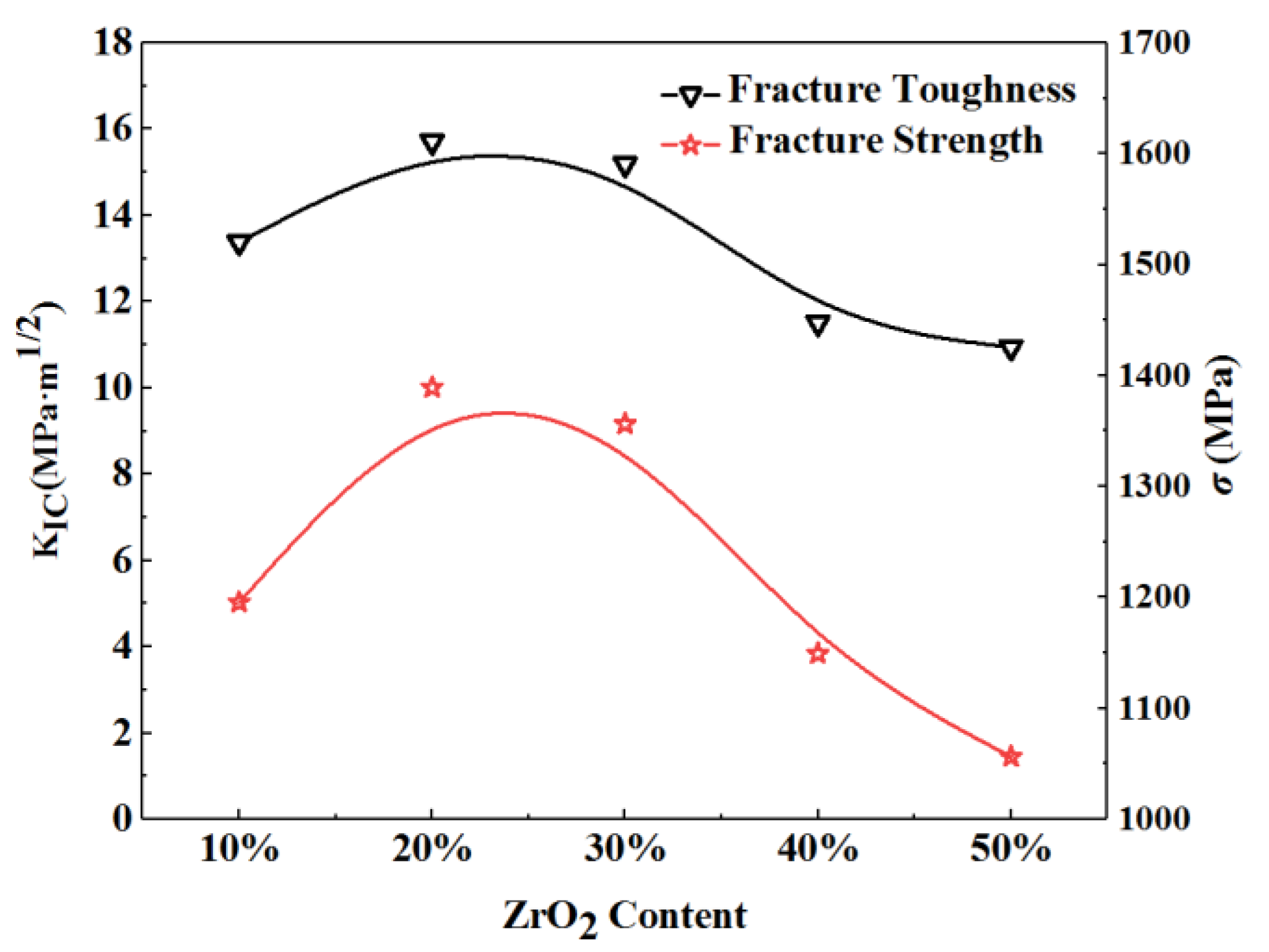


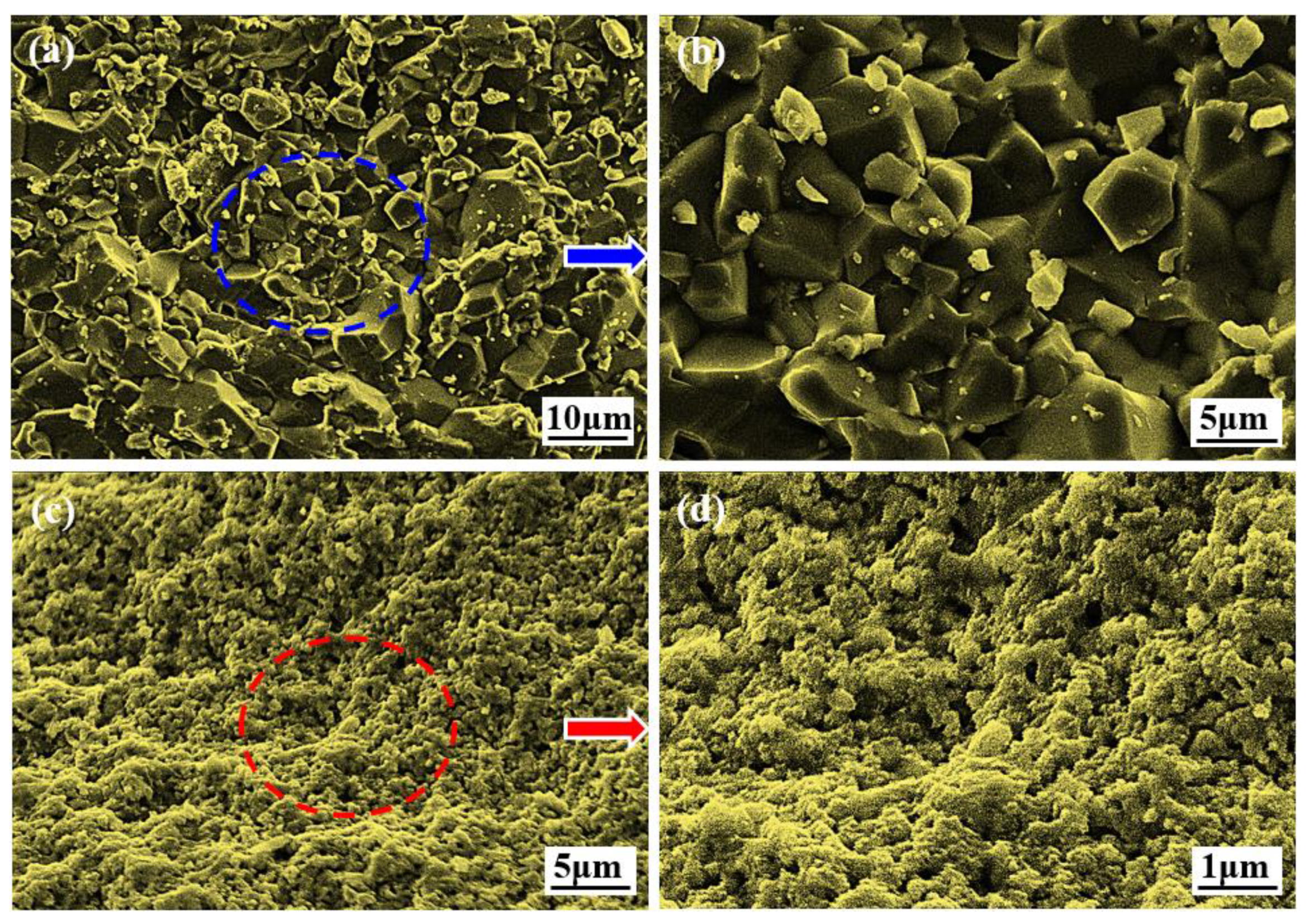

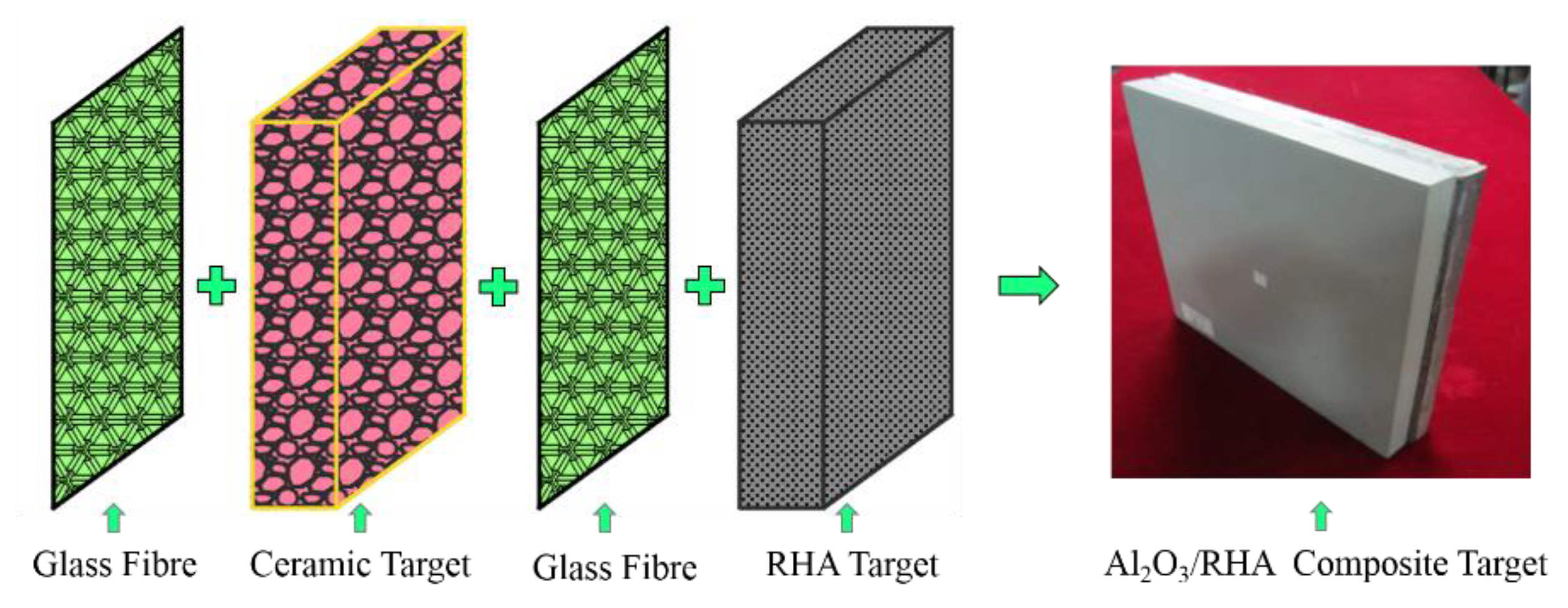


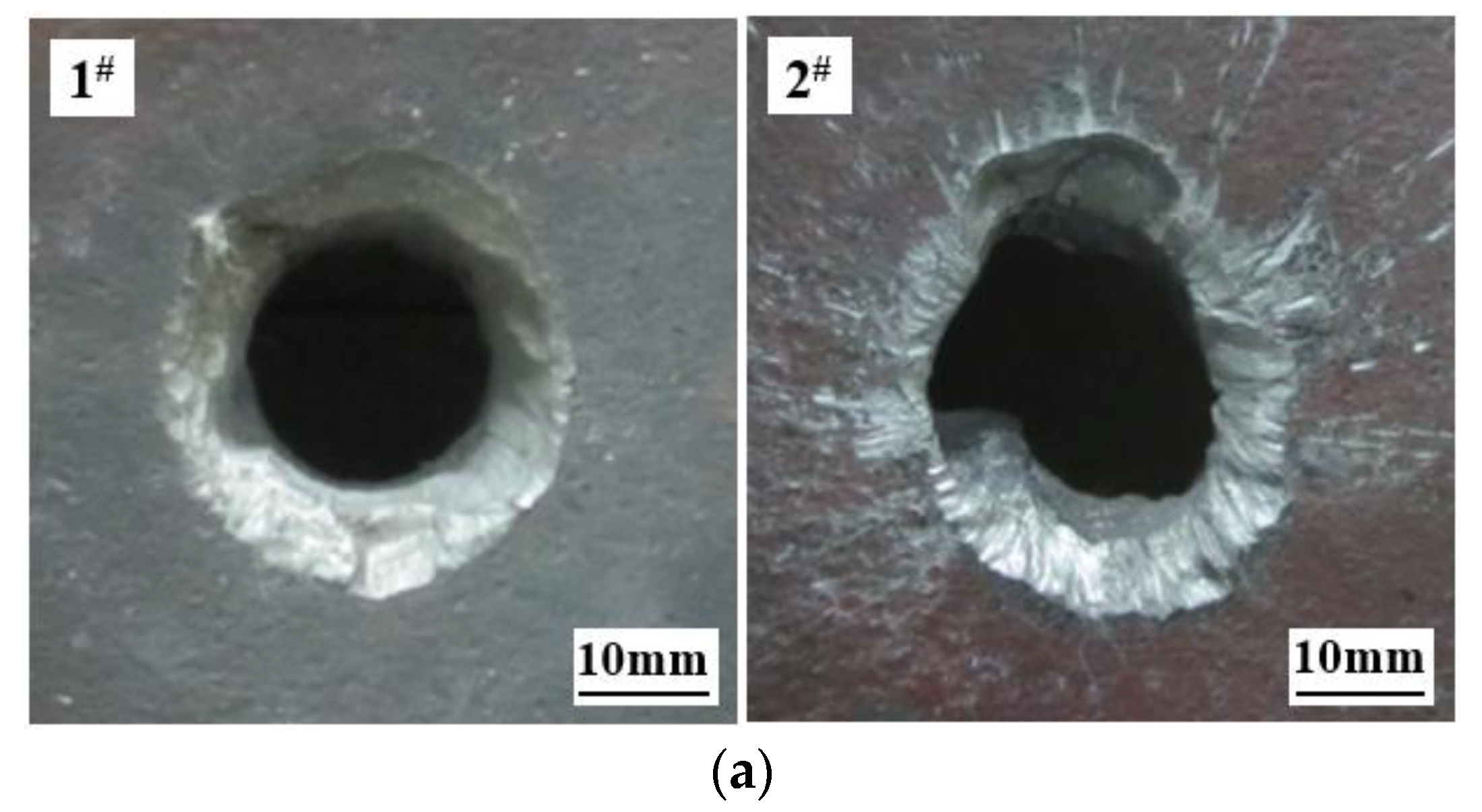
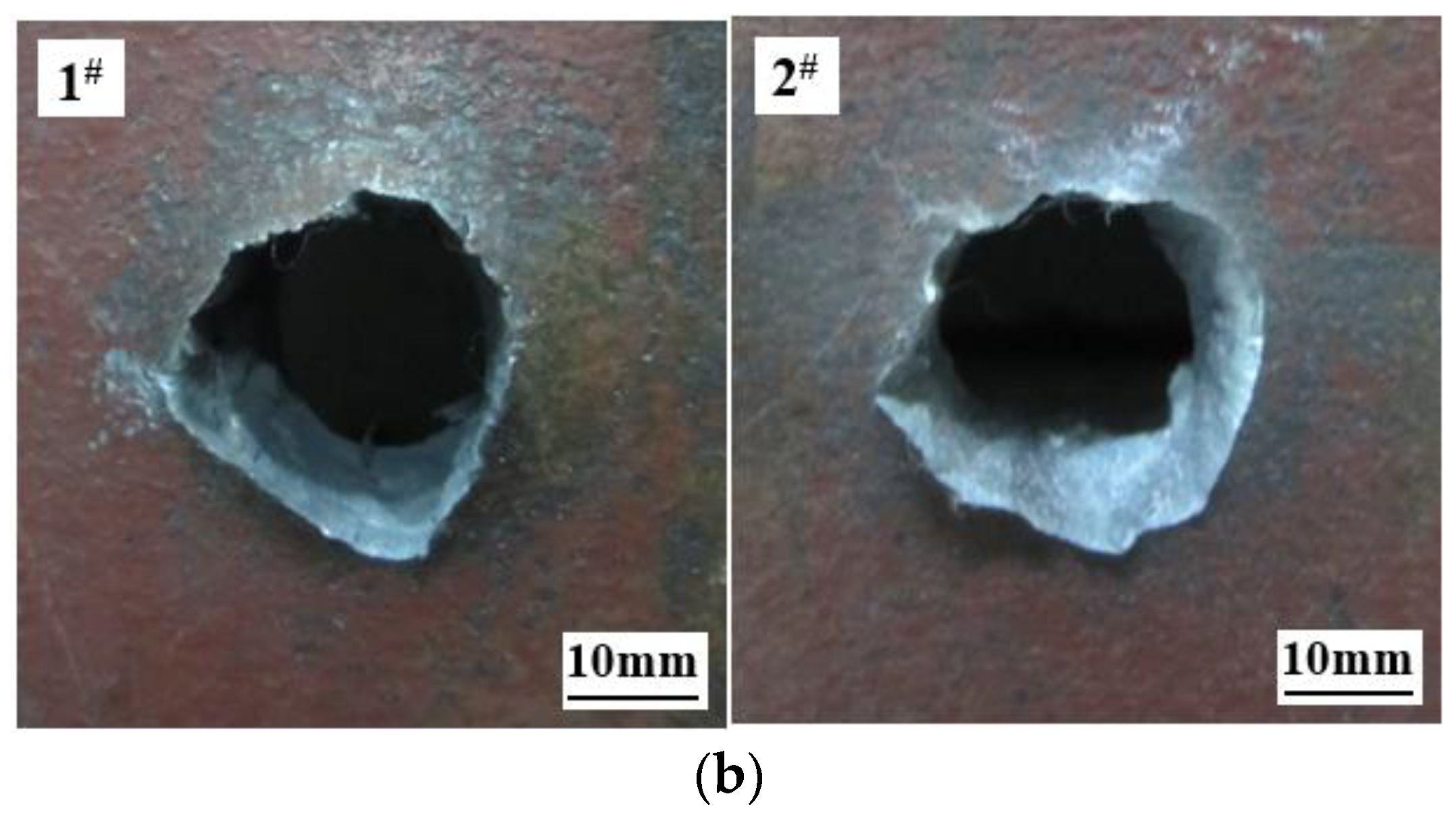


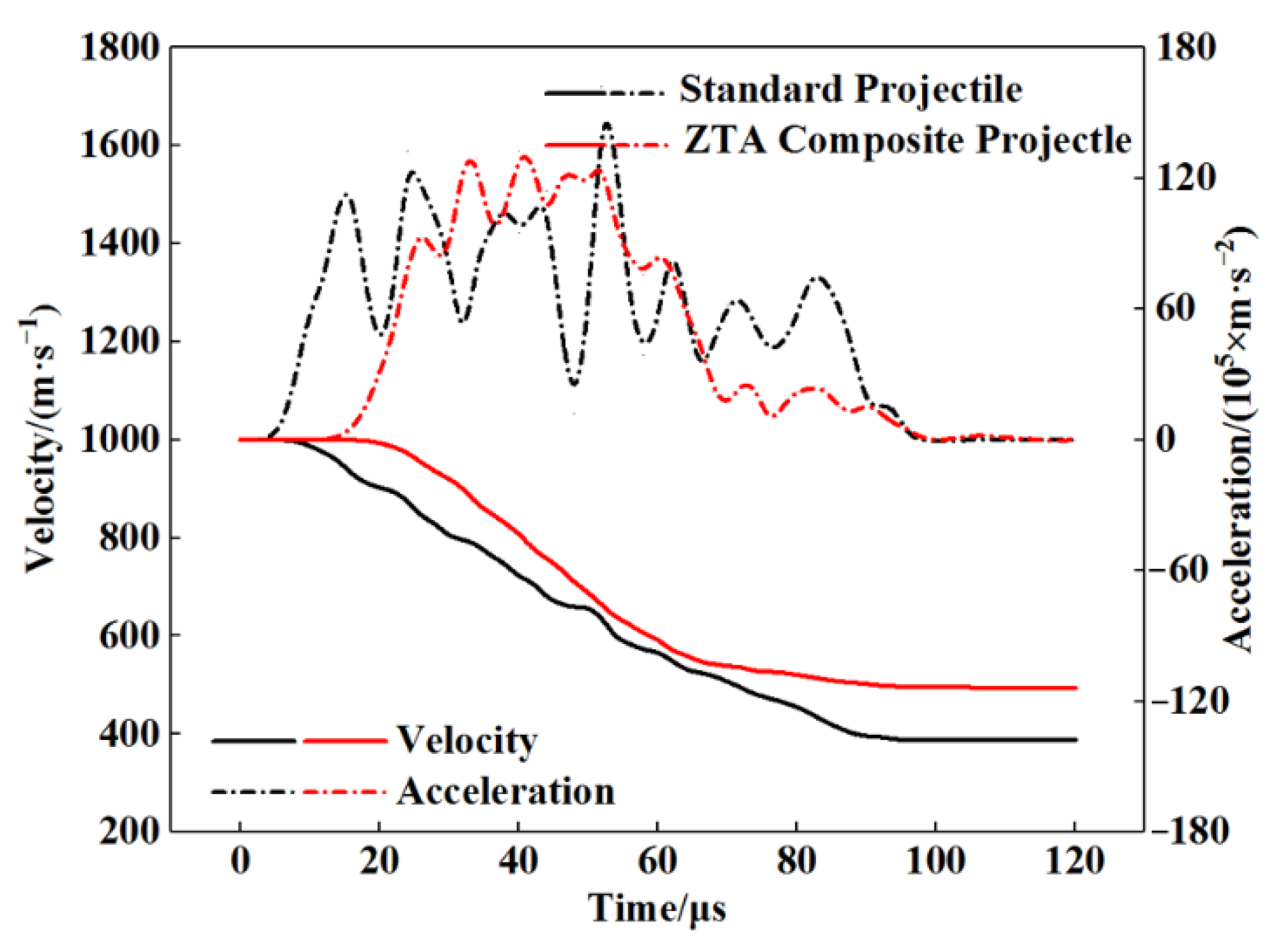

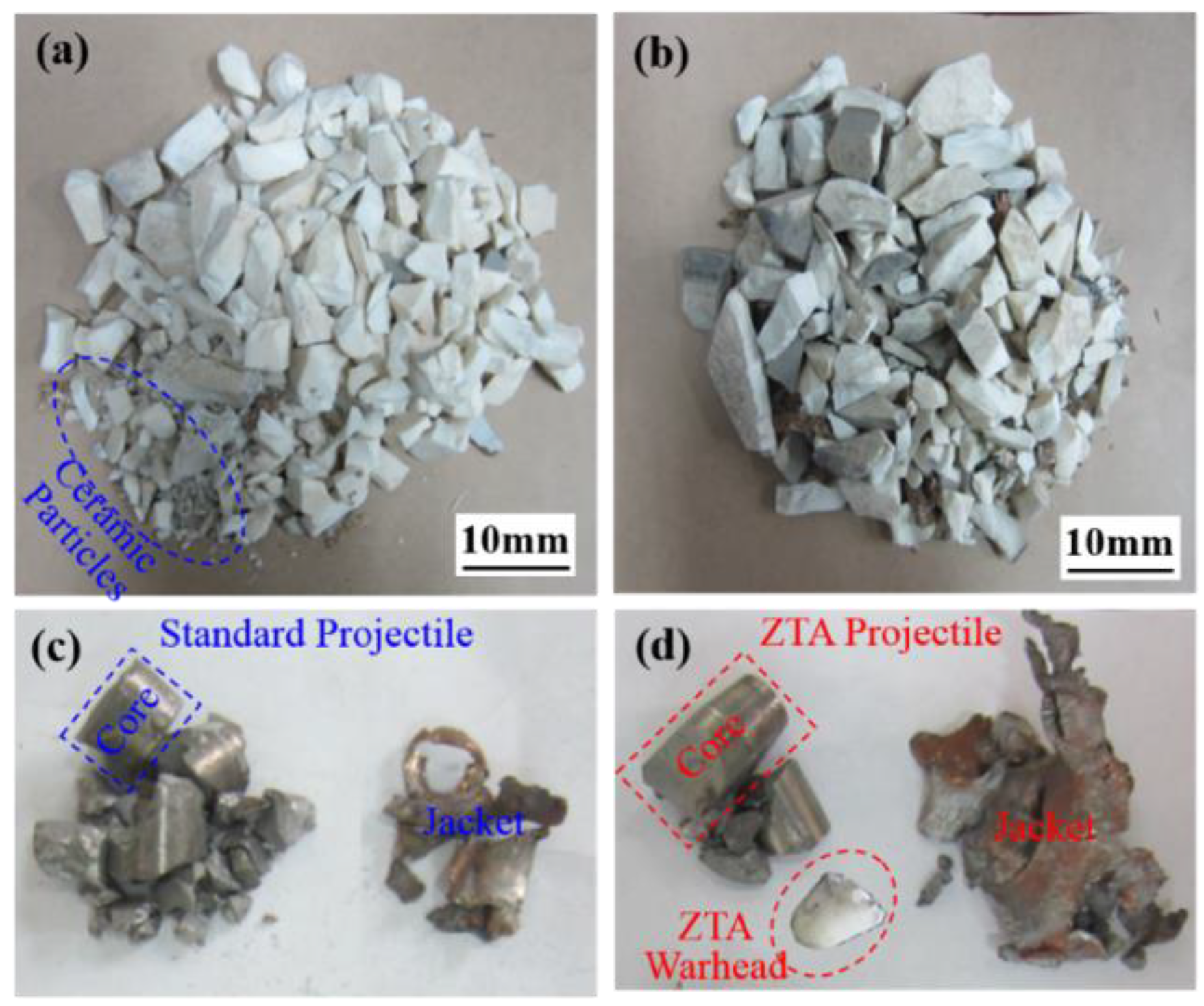
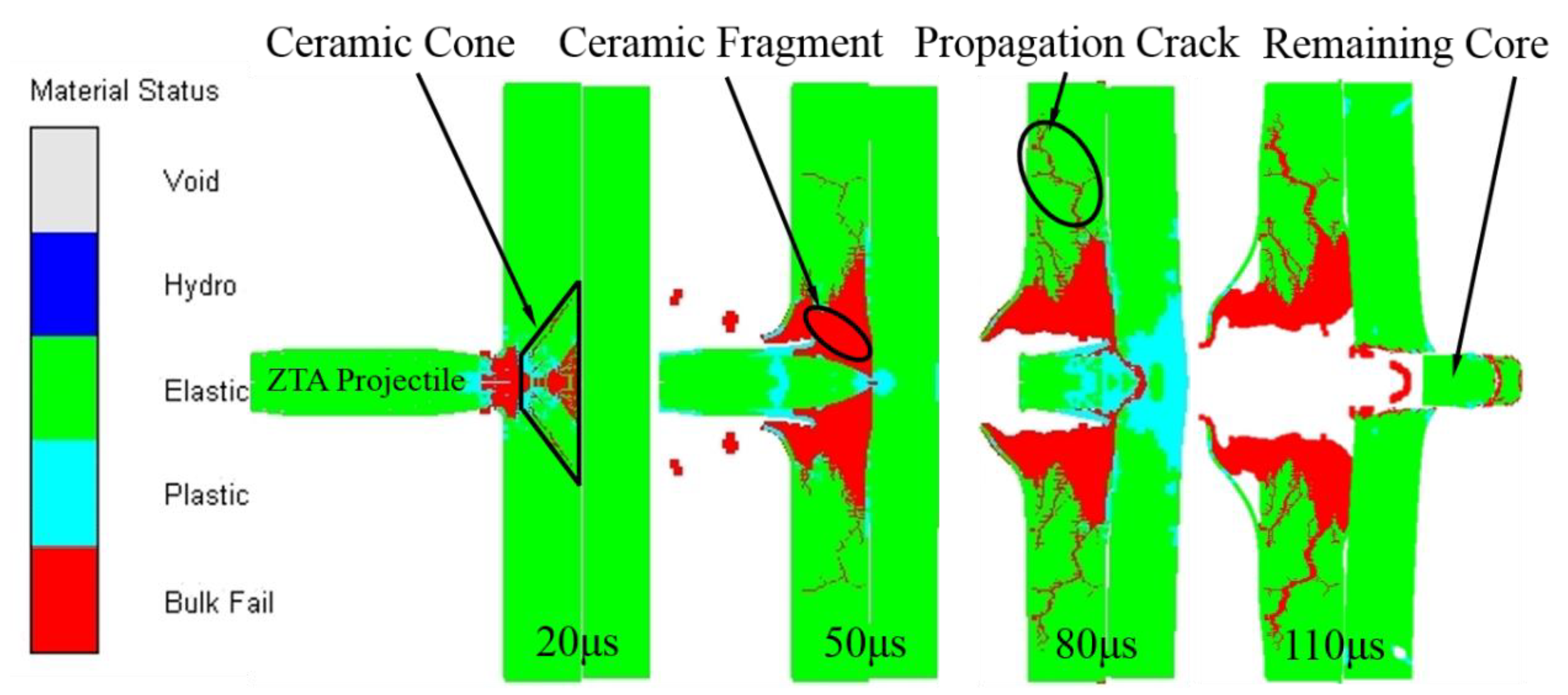
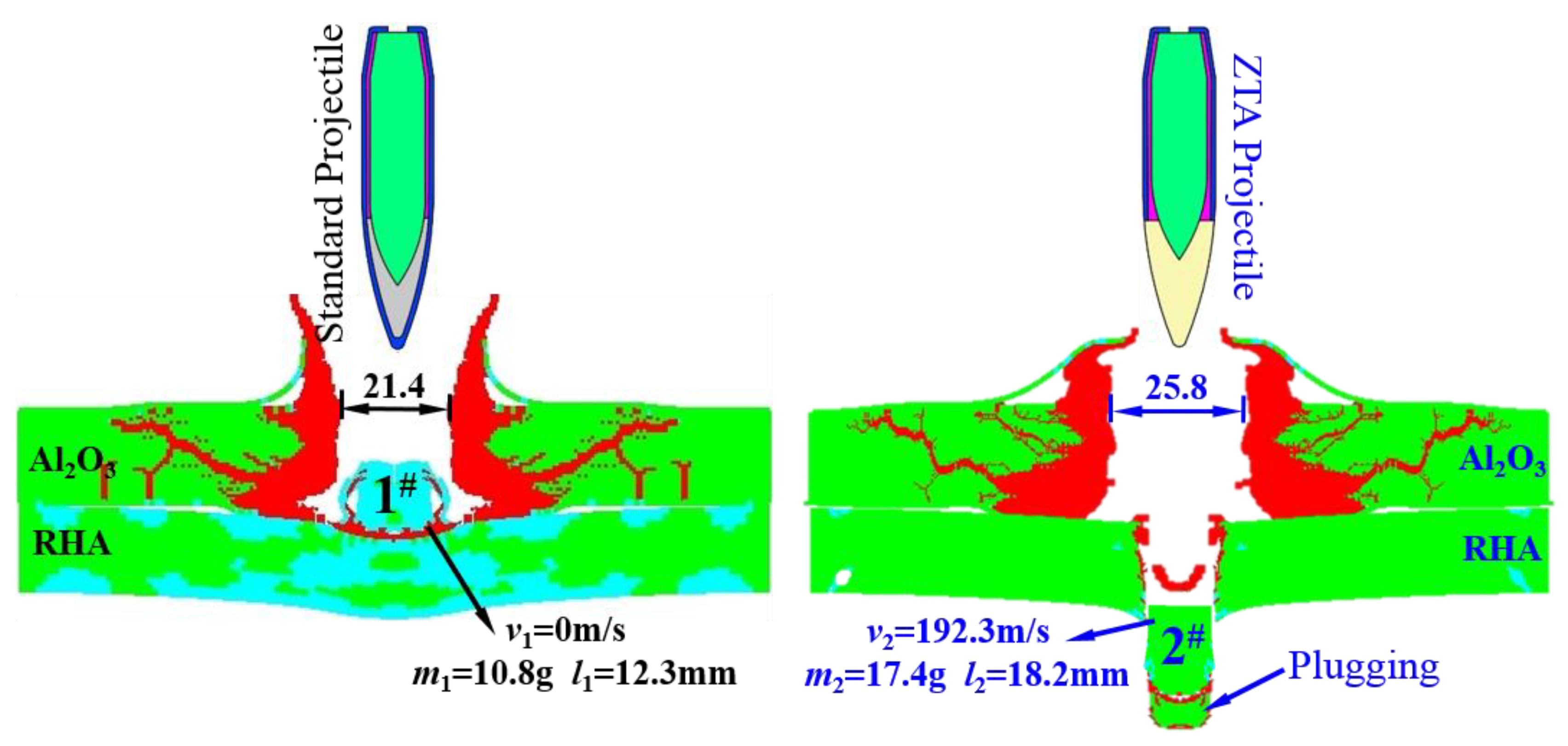
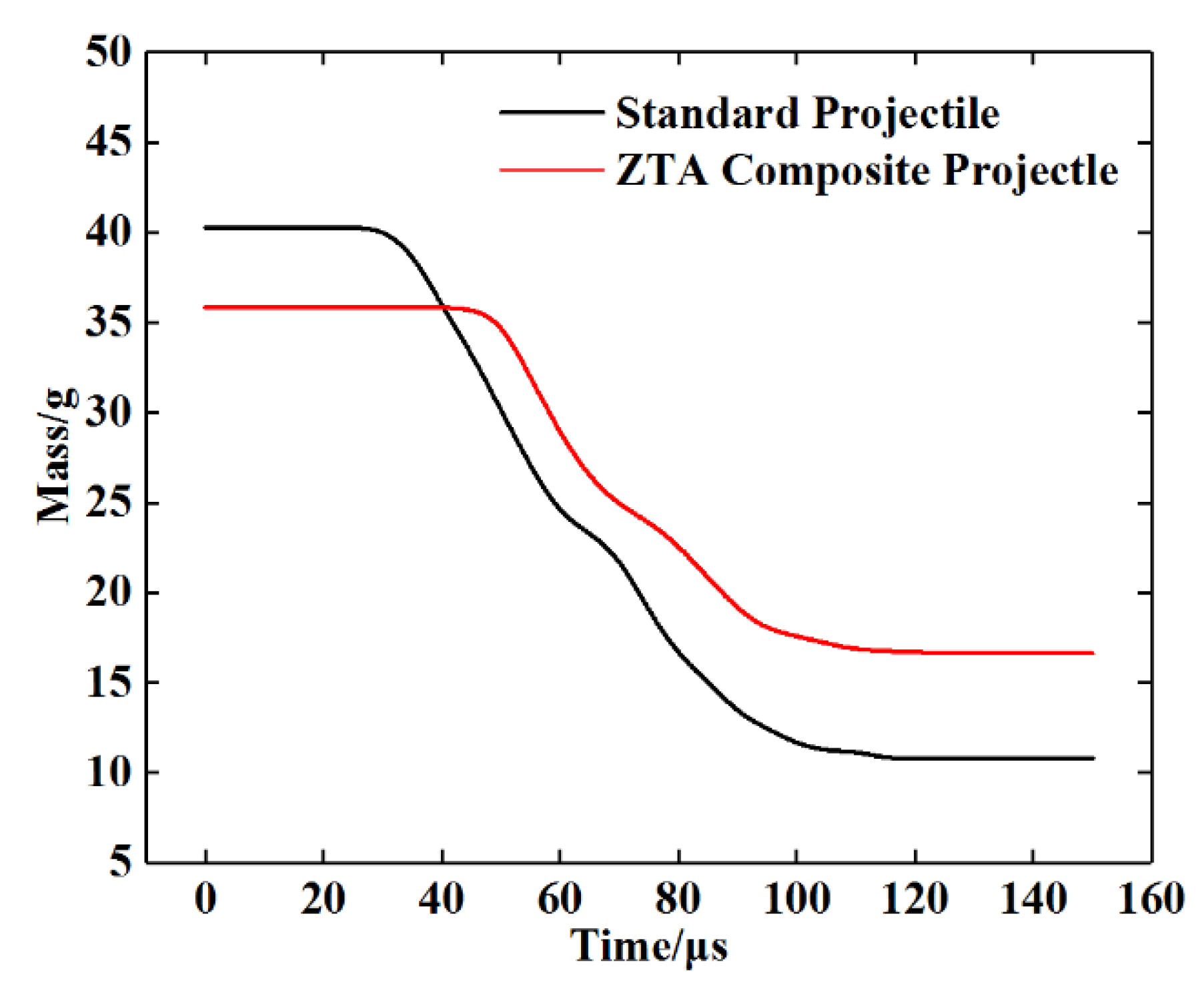
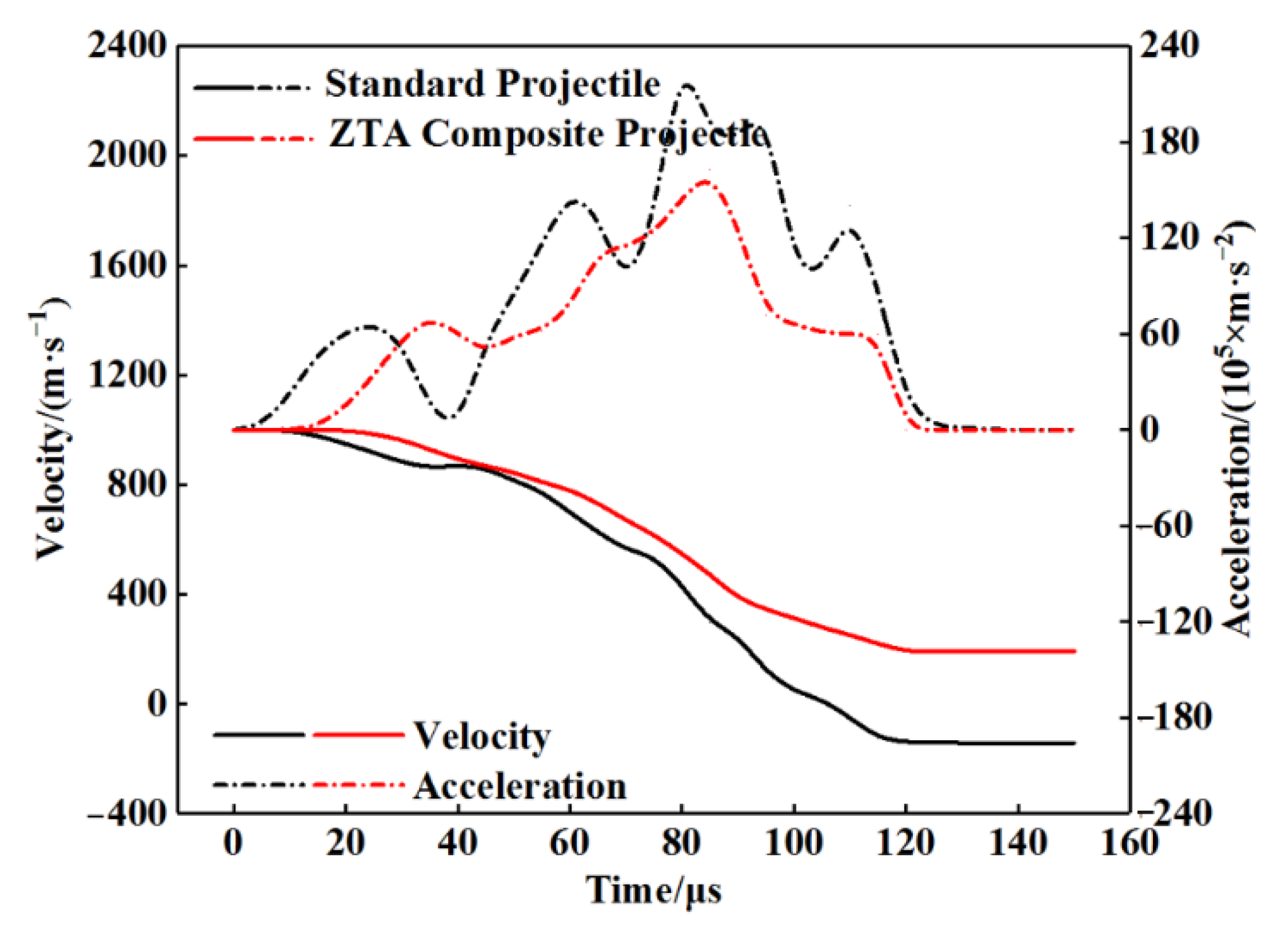

| Material | Relative Density | Flexural Strength (MPa) | Fracture Toughness (MPa·m1/2) | Vickers Hardness (GPa) |
|---|---|---|---|---|
| ZTA Ceramics | 98.5% | 1026 | 9.65 | 17.39 |
| No. | Projectile Type | Projectile | Metal Core | ||||
|---|---|---|---|---|---|---|---|
| Diameter /mm | Length /mm | Mass /g | Diameter /mm | Length /mm | Mass /g | ||
| 1# | Standard Projectile | 14.9 | 66.7 | 63.9 | 12.4 | 52.4 | 40.3 |
| 2# | ZTA Composite Projectile | 14.9 | 66.7 | 63.9 | 12.4 | 47.6 | 35.8 |
| Materials | ρ/(g·cm−3) | G/GPa | HEL/GPa | A | B | C | M | N |
|---|---|---|---|---|---|---|---|---|
| Al2O3 | 3.93 | 90.1 | 4.31 | 0.90 | 0.31 | 0.007 | 0.35 | 0.60 |
| ZTA | 5.90 | 152 | 6.57 | 0.93 | 0.72 | 0.007 | 0.38 | 0.64 |
| No. | Projectile Structure | Core Initial Mass | Initial Velocity (m/s) | Core Residual Mass | Leaving Velocity (m/s) | Damage of Armored Steel Target | |
|---|---|---|---|---|---|---|---|
| Entrance (mm) | Exit (mm) | ||||||
| 1#-a | Standard projectile | 40.3 g | 1012.4 | 20.6 g | 450.9 | Ø 19.2 | Ø 15.6 |
| 1#-b | 1003.2 | 19.8 g | 423.6 | Ø 19.3 | Ø 15.8 | ||
| 1#-c | 1011.8 | 21.1 g | 427.8 | Ø 18.2 | Ø 16.9 | ||
| 2#-a | ZTA Composite Projectile | 35.8 g | 1011.7 | 29.8 g | 514.4 | 22.9 × 15.7 | 17.8 × 15.7 |
| 2#-b | 1005.9 | 21.3 g | 522.3 | 21.9 × 16.3 | 17.7 × 15.4 | ||
| 2#-c | 1009.1 | 26.6 g | 513.4 | 23.6 × 15.1 | 19.4 × 16.6 | ||
| No. | Projectile Structure | Core Initial Mass | Initial Velocity (m/s) | Core Residual Mass | Leaving Velocity (m/s) | Damage of Armored Steel Target | |
|---|---|---|---|---|---|---|---|
| Hole Entry (mm) | Hole Exit (mm) | ||||||
| 1# | Standard Projectile | 40.3 g | 1000 | 19.5 g | 388.8 | Ø 18.7 | Ø 14.9 |
| 2# | ZTA Composite Projectile | 35.8 g | 1000 | 25.6 g | 493.9 | Ø 22.2 | Ø 15.6 |
| No. | Projectile Structure | Core Initial Mass | Initial Velocity (m/s) | Core Residual Mass | Leaving Velocity (m/s) | Damage Effect of Al2O3/RHA Composite Target |
|---|---|---|---|---|---|---|
| 1#-a | Standard Projectile | 40.3 g | 998.2 | 11.2 g | 0 | The projectile penetrated the glass fiber and Al2O3 ceramic layer but did not penetrate the armored steel plate. The average tear range of glass fiber was Ø 33.2 mm for the front surface and Ø 64.7 mm for the back surface. The Al2O3 ceramic panel was broken, and there were many crushed ceramic blocks. The front armor steel had Ø 35 mm impact marks; the average size of the crater was 5.6 mm × 4.2 mm with a depth of 2.2 mm; there was no damage to the back. |
| 1#-b | 1004.4 | 10.8 g | 0 | |||
| 1#-c | 1009.8 | 11.9 g | 0 | |||
| 2#-a | ZTA Composite Projectile | 35.8 g | 1001.7 | 18.4 g | 234.0 | The projectile completely penetrated the Al2O3/RHA composite armor. The average tear range of glass fiber was 37.9 mm × 25.3 mm on the front surface, and 90.7 mm × 63.2 mm on the back surface. The Al2O3 ceramic panel was broken; the size of fragments was relatively uniform. Fillings were formed when the projectile penetrated the armor steel; the average sizes of the front and back bullet holes were 21.5 mm × 19.2 mm and 22.3 mm × 16.9 mm. |
| 2#-b | 996.9 | 17.6 g | 231.4 | |||
| 2#-c | 1007.4 | 19.2 g | 257.9 |
| No. | Projectile Structure | Core Initial Mass | Initial Velocity (m/s) | Core Residual Mass | Leaving Velocity (m/s) | Damage Effect of Al2O3/RHA Composite Target |
|---|---|---|---|---|---|---|
| 1# | Standard Projectile | 40.3 g | 1000 | 10.8 g | 0 | The Al2O3 ceramic panel was broken; the damage range was Ø 119.6 mm. The projectile failed to penetrate the back target of the armored steel; the penetration depth was 1.3 mm. |
| 2# | ZTA Composite Projectile | 35.8 g | 1000 | 17.4 g | 192.3 | The Al2O3 ceramic panel was broken with Ø 109.7 mm of the damage range. The projectile penetrated the back target of the 15 mm armored steel and formed a filling. |
Publisher’s Note: MDPI stays neutral with regard to jurisdictional claims in published maps and institutional affiliations. |
© 2022 by the authors. Licensee MDPI, Basel, Switzerland. This article is an open access article distributed under the terms and conditions of the Creative Commons Attribution (CC BY) license (https://creativecommons.org/licenses/by/4.0/).
Share and Cite
Yang, R.; Li, K.; Yin, L.; Ren, K.; Cheng, Y.; Li, T.; Fu, J.; Zhao, T.; Chen, Z.; Yang, J. Study on the Penetration Power of ZrO2 Toughened Al2O3 Ceramic Composite Projectile into Ceramic Composite Armor. Materials 2022, 15, 2909. https://doi.org/10.3390/ma15082909
Yang R, Li K, Yin L, Ren K, Cheng Y, Li T, Fu J, Zhao T, Chen Z, Yang J. Study on the Penetration Power of ZrO2 Toughened Al2O3 Ceramic Composite Projectile into Ceramic Composite Armor. Materials. 2022; 15(8):2909. https://doi.org/10.3390/ma15082909
Chicago/Turabian StyleYang, Rui, Kuiwu Li, Likui Yin, Kai Ren, Yu Cheng, Taotao Li, Jianping Fu, Taiyong Zhao, Zhigang Chen, and Jinlong Yang. 2022. "Study on the Penetration Power of ZrO2 Toughened Al2O3 Ceramic Composite Projectile into Ceramic Composite Armor" Materials 15, no. 8: 2909. https://doi.org/10.3390/ma15082909






